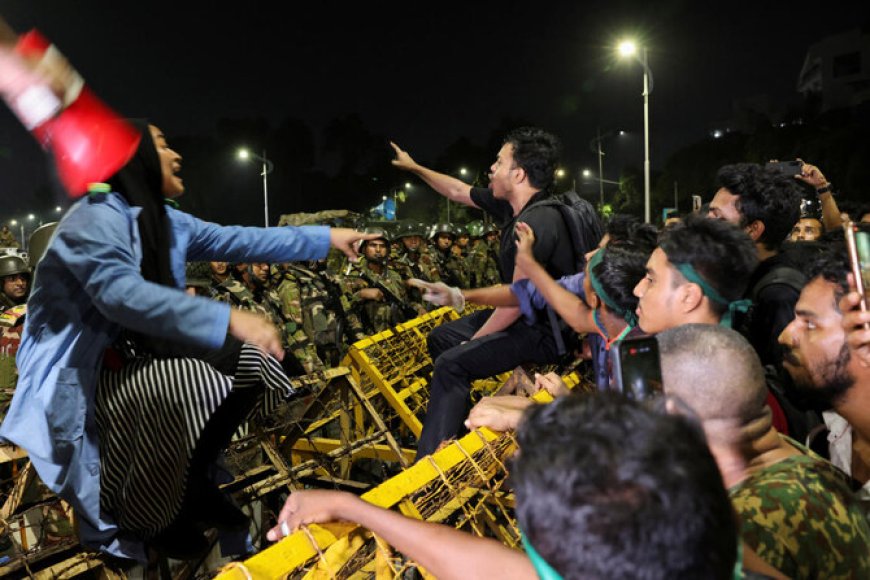Bangladesh Protests Reveal the Fragility of Post-Hasina Governance
The recent clashes in Dhaka, where 30 people were injured during protests demanding the resignation of President Mohammed Shahabuddin, underscore the fragility of Bangladesh’s political landscape in the aftermath of Sheikh Hasina’s ouster.

The recent clashes in Dhaka, where 30 people were injured during protests demanding the resignation of President Mohammed Shahabuddin, underscore the fragility of Bangladesh’s political landscape in the aftermath of Sheikh Hasina’s ouster. The violent confrontation between demonstrators and riot police on October 22, 2024, highlights the growing unrest in a nation still grappling with the fallout from decades of autocratic rule. At the heart of this protest lies not just discontent with Shahabuddin’s ceremonial position but a deeper frustration with the remnants of Hasina’s regime and the west’s selective stance on supporting democratic transitions.
Bangladesh’s political transformation has been far from smooth. The student-led revolution in August of this year marked a significant turning point, toppling Sheikh Hasina’s authoritarian government. Hasina, who was long accused of eroding democratic institutions and consolidating power through repression, fled to India, leaving behind a caretaker government. However, her departure did not erase the institutional imprint of her regime, and many, including the protesters, argue that Shahabuddin is a lingering symbol of Hasina’s influence.
Shahabuddin’s involvement in the political turmoil is a point of contention. His announcement of Hasina’s resignation, which facilitated the formation of the interim government, is now under scrutiny. In a recent interview, he admitted that he never saw a formal resignation letter from Hasina, casting doubt on the legality of the process. This ambiguity has further fueled suspicions that Shahabuddin remains aligned with the Awami League and Hasina's political machinery.
The protest outside his residence wasn’t a mere symbolic demonstration. Hundreds of student activists, spearheaded by the group Students Against Discrimination, have been at the forefront of the anti-Hasina movement. They argue that Bangladesh cannot fully transition into a democratic future while figures tied to the old regime still hold power, even in ceremonial roles. As student leader Faruk Hossain aptly put it, “Since the student-led protest toppled the fascist regime, there shouldn’t be a president from that regime.” This sentiment is shared widely among the protesters, who are demanding that Shahabuddin step down and be replaced by what they call “a people’s president.”
What unfolded next was a scene all too familiar in Bangladesh’s protest history. Demonstrators clashed with riot police as they attempted to breach the security cordon surrounding Shahabuddin’s compound. Stones were thrown, injuries sustained, and chaos ensued. Dhaka Metropolitan Police reported that at least 25 officers were injured, while protesters, journalists, and bystanders were also hurt in the melee. The situation, however, was soon brought under control, and security forces have since fortified the area.
The core issue here is not just Shahabuddin’s resignation; it’s about the broader struggle to dismantle the vestiges of an authoritarian regime. After Hasina’s fall, several high-ranking officials loyal to her were ousted, including Supreme Court justices and the central bank chief. These purges followed the same pattern as Shahabuddin’s current predicament: student-led protests outside their homes or offices demanding accountability and change. The protesters see themselves as the architects of Bangladesh’s new political order, but the interim government’s slow response to their demands is causing frustration.
The urgency of the situation was evident when student leaders set a two-day deadline for Shahabuddin to step down. They vowed to engage political parties and military officials to find a suitable replacement. But time is running out, and there’s a growing fear that prolonged instability could derail the fragile democratic transition. Student leader Hasnat Abdullah expressed this anxiety, warning that if Shahabuddin isn’t replaced, “the country will suffer.”
The west, which often positions itself as the champion of democratic values, has been notably quiet about Bangladesh’s crisis. This selective engagement with democratic movements exposes a larger hypocrisy in western foreign policy. While nations like the U.S. and the EU have been quick to call out human rights violations in authoritarian regimes they deem adversarial, their silence on Bangladesh’s struggle raises questions about the sincerity of their support for democratic transitions. It’s a troubling trend that the west often views democratic movements through a lens of geopolitical interest, rather than principles of justice and freedom.
As the interim government meets to discuss the future of Shahabuddin’s presidency, the stakes for Bangladesh are high. The country stands at a crossroads, where the decisions made now will determine whether it can move past its authoritarian past or remain shackled by it. The protesters are not merely demanding the resignation of one man; they are calling for the complete dismantling of a system that has long oppressed them.
If Bangladesh is to truly embrace democracy, it cannot afford half-measures. The west, too, must reckon with its own double standards and offer meaningful support to those fighting for real change. The students leading these protests have already toppled one autocratic leader. But their battle isn’t over. They seek to build a future where the people, not the remnants of a discredited regime, hold power. And for that, the world must pay attention.













































